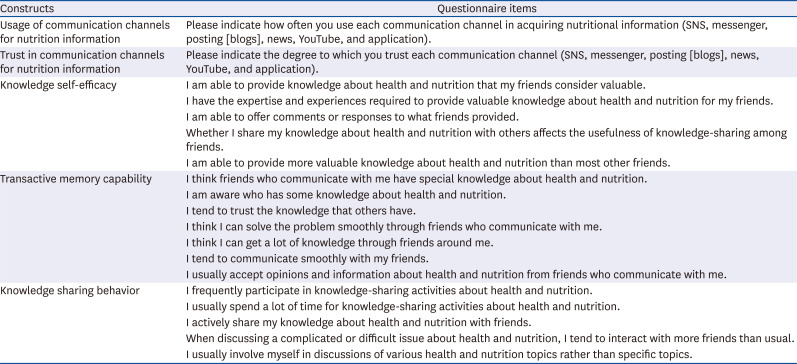1. Currie J, Della Vigna S, Moretti E, Pathania V. The effect of fast food restaurants on obesity and weight gain. Am Econ J. 2010; 2:32–63.

2. Drichoutis AC, Nayga RM Jr, Lazaridis P. Nutritional labeling. In : Lusk JL, Roosen J, Shogren J, editors. The Oxford Handbook of the Economics of Food Consumption and Policy. Oxford: Oxford University Press;2011. p. 520–545.
3. Ogden CL, Carroll MD, Curtin LR, Lamb MM, Flegal KM. Prevalence of high body mass index in US children and adolescents, 2007-2008. JAMA. 2010; 303:242–249. PMID:
20071470.

5. Burton S, Creyer EH, Kees J, Huggins K. Attacking the obesity epidemic: the potential health benefits of providing nutrition information in restaurants. Am J Public Health. 2006; 96:1669–1675. PMID:
16873758.

6. Boger CA Jr. Food labeling for restaurants: fact versus fiction. Cornell Hotel Restaur Adm Q. 1995; 36:62–70.

7. Conklin MT, Lambert CU, Cranage DA. Nutrition information at point of selection could benefit college students. Topics Clin Nutr. 2005; 20:90–96.

8. Kozup JC, Creyer EH, Burton S. Making healthful food choices: the influence of health claims and nutrition information on consumers' evaluations of packaged food products and restaurant menu items. J Mark. 2003; 67:19–34.

9. Kral TV, Roe LS, Rolls BJ. Does nutrition information about the energy density of meals affect food intake in normal-weight women? Appetite. 2002; 39:137–145. PMID:
12354682.

10. Sproul AD, Canter DD, Schmidt JB. Does point-of-purchase nutrition labeling influence meal selections? A test in an Army cafeteria. Mil Med. 2003; 168:556–560. PMID:
12901467.

11. Roe B, Levy AS, Derby BM. The impact of health claims on consumer search and product evaluation outcomes: results from FDA experimental data. J Public Policy Mark. 1999; 18:89–105.

12. Wansink B, Painter J, van Ittersum K. Descriptive menu labels' effect on sales. Cornell Hotel Restaur Adm Q. 2001; 42:68–72.

13. Variyam J. Nutrition Labeling in the Food-away-from-Home Sector: an Economic Assessment. Economic Research Report No. (ERR-4). Washington, D.C.: United States Department of Agriculture;2005.
14. Cooke R, Papadaki A. Nutrition label use mediates the positive relationship between nutrition knowledge and attitudes towards healthy eating with dietary quality among university students in the UK. Appetite. 2014; 83:297–303. PMID:
25218881.

15. Deshpande S, Basil MD, Basil DZ. Factors influencing healthy eating habits among college students: an application of the health belief model. Health Mark Q. 2009; 26:145–164. PMID:
19408181.

16. Graham DJ, Laska MN. Nutrition label use partially mediates the relationship between attitude toward healthy eating and overall dietary quality among college students. J Acad Nutr Diet. 2012; 112:414–418. PMID:
22896856.

17. Martinez OD, Roberto CA, Kim JH, Schwartz MB, Brownell KD. A survey of undergraduate student perceptions and use of nutrition information labels in a university dining hall. Health Educ J. 2012; 72:319–325.

18. Robinson E, Fleming A, Higgs S. Prompting healthier eating: testing the use of health and social norm based messages. Health Psychol. 2014; 33:1057–1064. PMID:
24295025.

19. Croker H, Whitaker KL, Cooke L, Wardle J. Do social norms affect intended food choice? Prev Med. 2009; 49:190–193. PMID:
19619576.

20. Kwahk KY, Park DH. The effects of network sharing on knowledge-sharing activities and job performance in enterprise social media environments. Comput Human Behav. 2016; 55:826–839.

21. Kwahk KY, Park DH. Leveraging your knowledge to my performance: the impact of transactive memory capability on job performance in a social media environment. Comput Human Behav. 2018; 80:314–330.

22. Burford S, Park S. The impact of mobile tablet devices on human information behavior. J Doc. 2014; 70:622–639.
23. Bellur S, Nowak KL, Hull KS. Make it our time: In class multitaskers have lower academic performance. Comput Human Behav. 2015; 53:63–70.

25. Fox S, Duggan M. Health Online 2013. Washington, D.C.: Pew Research Center's Internet & American Life Project;2013.
26. Thackeray R, Crookston BT, West JH. Correlates of health-related social media use among adults. J Med Internet Res. 2013; 15:e21. PMID:
23367505.

28. Academy of Nutrition and Dietetics. eatright.org [Internet]. Cleveland (OH): Academy of Nutrition and Dietetics;2014. cited 2019 November 13. Available from:
http://www.eatright.org.
29. U.S. Food and Drug Administration. Food labelling: nutrition labelling of standard menu items in restaurants and similar retail food establishments. Final regulatory impact analysis [Internet]. Silver Spring (MD): U.S. Food and Drug Administration;2014. cited 2019 December 15. Available from:
https://www.fda.gov/media/116833/download.
30. Ministry of Food and Drug Safety. Korean government has enacted the special act on children's food safety and nutrition [Internet]. Cheongju: Ministry of Food and Drug Safety;2016. cited 2019 November 17. Available from:
http://www.mfds.go.kr/index.do.
31. Kwahk KY. The impacts of social networks on individual adaptation to technochanges. Asia Pac J Inf Syst. 2011; 21:29–47.
32. Subrahmanyam K, Greenfield P. Online communication and adolescent relationships. Future Child. 2008; 18:119–146.
33. Kankanhallid A, Tan BC, Wei KK. Contributing knowledge to electronic knowledge repositories: an empirical investigation. Manage Inf Syst Q. 2005; 29:113–143.
34. Kim CS, Kwahk KY. Effects of network positions of organizational members on knowledge sharing. Knowl Manag Res. 2015; 16:67–89.
35. Hsu MH, Ju TL, Yen CH, Chang CM. Knowledge sharing behavior in virtual communities: the relationship between trust, self-efficacy, and outcome expectation. Int J Hum Comput Stud. 2007; 65:153–169.
36. Cortina JM. What is coefficient alpha? An examination of theory and applications. J Appl Psychol. 1993; 78:98–104.










 PDF
PDF Citation
Citation Print
Print




 XML Download
XML Download